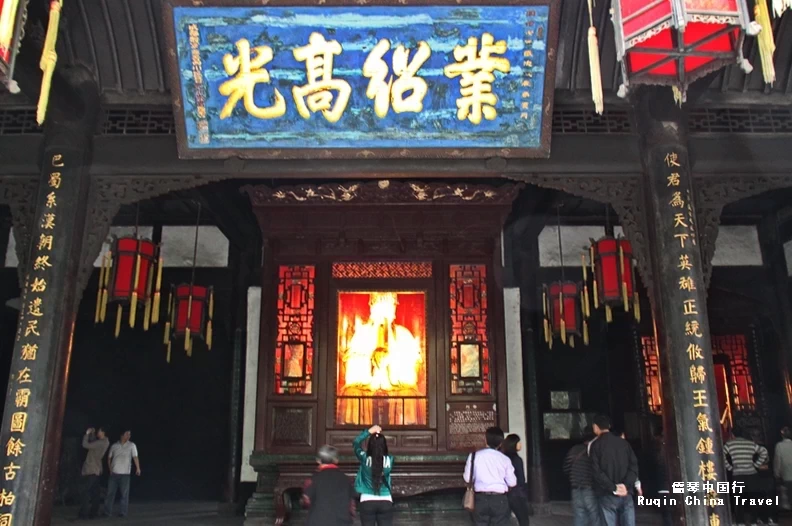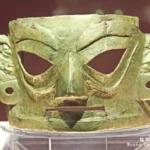In this complete guide, we’ll walk you through everything you need to know about how to visit Chengdu Wuhou Temple, what to see inside, the temple’s history, and some practical travel tips to enhance your visit.
Chengdu, the capital of Sichuan Province, is famous for its rich history, vibrant culture, and delicious cuisine. Among its many historical attractions, the Wuhou Temple (also known as Wu Hou Shrine, or Wuhou Temple of Marquis or Temple of Marquis Wu, or just Wuhou Shrine) is a must-see. It’s one of the most important temples in China, honoring the legendary strategist Zhuge Liang and his lord, Liu Bei. Whether you’re a history buff, a cultural enthusiast, or simply curious about Chengdu’s past, visiting Wuhou Temple offers a fascinating journey into the history of the Three Kingdoms period.
1. A Brief History of Wuhou Temple
The Wuhou Memorial Temple dates back to the Shu Kingdom during the Three Kingdoms period (220-280 AD). The temple was built to honor Zhuge Liang, the famous military strategist and advisor to Liu Bei, the founding emperor of Shu. Zhuge Liang, also known as the Marquis of Wu, became a symbol of wisdom, loyalty, and righteousness in Chinese culture.
The temple complex also pays homage to Liu Bei and other notable figures from the Shu Kingdom. Over the centuries, the temple has undergone multiple renovations, but it has always maintained its deep cultural significance.
2. What to See Inside Wuhou Temple
When you visit Wuhou Temple Chengdu, you’ll encounter a variety of historical and cultural landmarks. Here’s a breakdown of the main highlights:
1)Triple-Success Stele
Upon entering, one of the first sights is the famous Triple-Success Stele, erected in honor of Liu Bei, Zhuge Liang, and Zhuge Liang’s son, Zhuge Zhan. The stele is unique for its historical importance and exquisite calligraphy. Additionally, it reflects the virtues of the Shu Kingdom leaders, including loyalty, wisdom, and benevolence.
2) Liu Bei Temple
Next, make your way to the Temple of Liu Bei. This temple is dedicated to the founder of the Shu Kingdom, Liu Bei. His tomb, known as the Tomb of Liu Bei, is located behind the main hall. This site is revered as a symbol of respect and admiration for Liu Bei, who is remembered as a compassionate and honorable ruler.
3) Zhuge Liang Temple
At the heart of Wuhou Temple is the Temple of Zhuge Liang. This temple is dedicated to the legendary military strategist, Zhuge Liang, whose wisdom and brilliance in battle earned him the status of a cultural icon. You’ll find statues of Zhuge Liang and historical artifacts that recount his achievements.
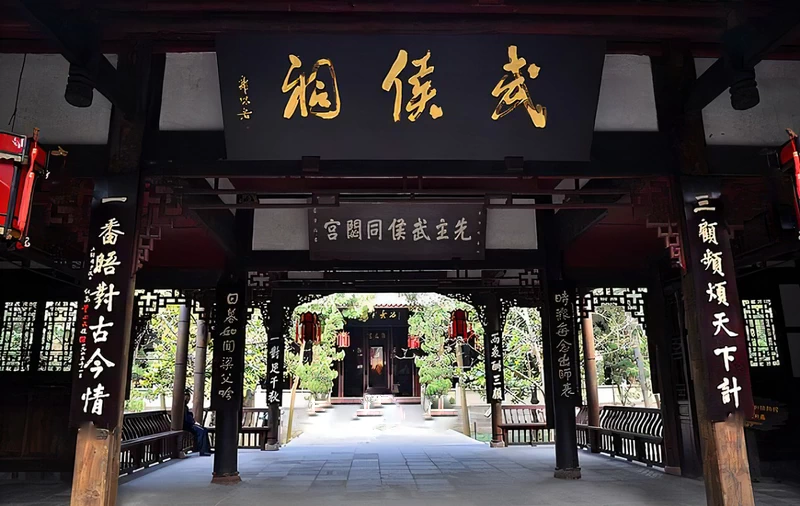
4) Sanyi Temple
Another significant landmark is the Sanyi Temple, also known as the Temple of the Three Righteous Ones. This temple honors the Oath of the Peach Garden, a legendary alliance between Liu Bei, Zhuge Liang, and Guan Yu. The temple symbolizes their unwavering loyalty and friendship.
5) Tomb of Liu Bei
One of the most important stops on your tour is the Tomb of Liu Bei, which is located in a peaceful garden behind the main temple. The tomb is a simple but solemn structure that reflects Liu Bei’s humble nature. The surrounding gardens offer a tranquil place for reflection.
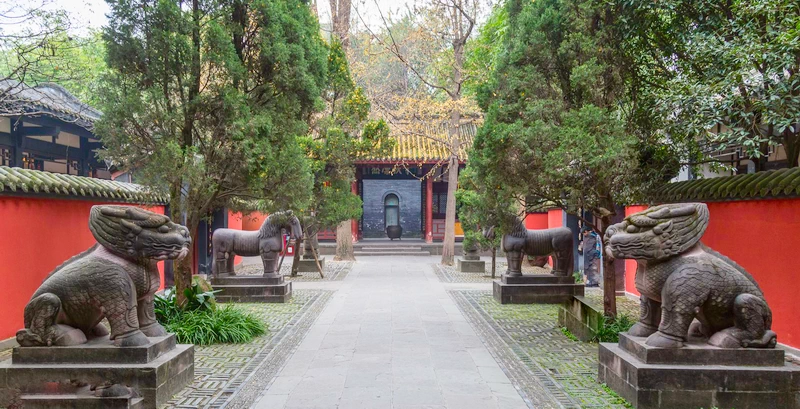
3. Recommended Route for Visiting Wuhou Temple
To make the most of your visit, follow this recommended route – Enter the Wuhou Shrine from the Main Gate in the south, then walk towards north and visit the four major sights in the shrine: Liu Bei Temple ( Hall ), Zhuge Liang Temple ( Hall), Sanyi Temple and end st the Tomb of Liu Bei. After finishing the tour of Wuhou Shrine, you will enter the famous ancient street of Jinli Street.
- Start at the Entrance: Begin by viewing the Triple-Success Stele (Tang Stele), which will give you a sense of the temple’s historical significance.
- Proceed to the Liu Bei Temple ( Liubei Hall ): Visit the Temple of Liu Bei to learn more about the founding emperor of the Shu Kingdom.
- Visit Zhuge Liang Temple (Zhuge Liang Hall): Take your time to explore the Temple of Zhuge Liang, which holds the essence of the temple complex.
- Stop at Sanyi Temple: Reflect on the story of friendship and loyalty among the three heroes at the Sanyi Temple.
- End at the Tomb of Liu Bei ( Hui Mausoleum): Complete your tour by visiting Liu Bei’s tomb, surrounded by lush gardens.
This route will help you navigate the temple efficiently while ensuring that you see the key highlights.
4. How to Get to Wuhou Temple Chengdu
Reaching Wuhou Temple is relatively easy. The temple is located in the Wuhou District, about 5 kilometers from the city center. Here are a few transportation options to get there:
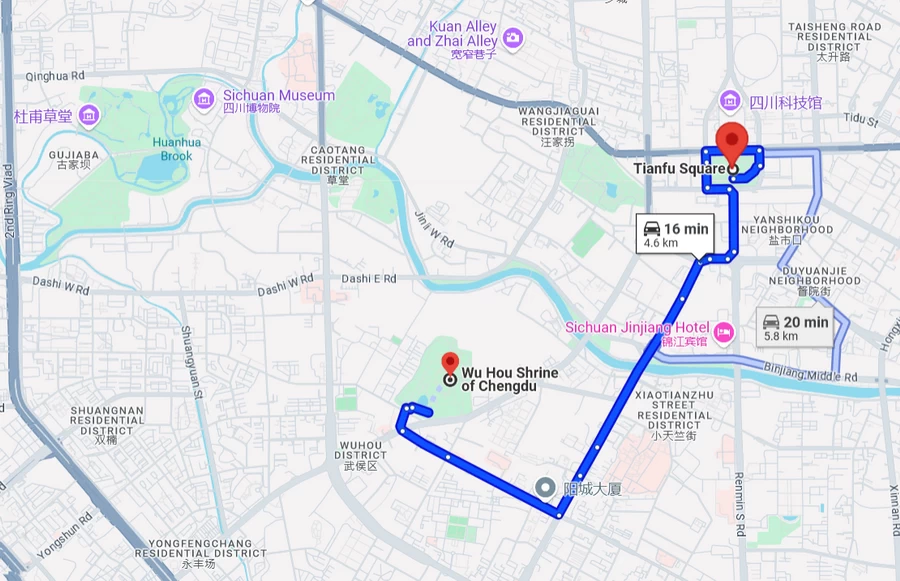
Wuhou Temple is located about 5 km to the southwest of Chengdu City centre ( Tuanfu Square )
Address: No.231 Wuhouci Street, Chengdu, China
Tel:+86-028-85552397
1. By Metro:
The most convenient way to get to Wuhou Temple is by Chengdu Metro. Take Line 3 and get off at Gaoshengqiao Station. From there, it’s a 10-minute walk to the temple.
2. By Taxi:
If you prefer a more direct route, taking a taxi is another option. The fare from Tianfu Square (the city center) to Wuhou Temple is around 20-30 RMB, depending on traffic.
3. By Bus:
For budget travelers, Chengdu’s public bus system is also efficient. You can take Bus No. 57, 82, 334, or several other lines that stop near the temple. Make sure to check the exact routes ahead of time.
5. Useful Wuhou Memorial Temple Travel Tips
Visiting Wuhou Temple Chengdu can be an enriching experience, especially if you’re well-prepared. Here are some practical tips to help you make the most of your trip:
1) Opening Hours:
The temple is open daily from 8:00 AM to 6:00 PM. It’s best to visit in the morning to avoid crowds, especially during weekends and holidays.
2) Ticket Prices:
The entrance fee is 50 RMB for adults, and there are discounts available for students and seniors. Tickets can be purchased at the entrance or online.
Book through Viator (great for English-speaking travelers):
👉Wuhou Temple Tours and Tickets
- 📍 Address: 231 Wuhou Shrine Street, Wuhou District
- 🚇 Metro: Line 3 to Gaoshengqiao Station, Exit D → 10-minute walk
- 📞 Phone: +86-28-85552397
3) Best Time to Visit:
The ideal time to visit is in the spring (March-May) or autumn (September-November) when the weather is mild. Chengdu summers can be hot and humid, making outdoor activities less enjoyable.
4) Wear Comfortable Shoes:
The temple grounds are extensive, and you’ll be doing a fair amount of walking. Wear comfortable shoes to explore the various sections without discomfort.
5) Photography:
Photography is allowed in most parts of the temple, but remember to be respectful of religious artifacts and visitors. Avoid using flash when taking photos indoors.
6. The Story of Zhuge Liang and Liu Bei
No visit to Wuhou Temple would be complete without understanding the story behind its most important figures—Zhuge Liang and Liu Bei. The relationship between these two historical figures is central to the Three Kingdoms period.
Zhuge Liang was a brilliant military strategist and statesman who served under Liu Bei. He was instrumental in helping Liu Bei establish the Shu Kingdom, and he continued to lead the kingdom after Liu Bei’s death. The story of their loyalty and mutual respect has become legendary in Chinese history, with Zhuge Liang often depicted as the epitome of wisdom and virtue.
7. Features and Highlights of Wuhou Temple Chengdu
The Wuhou Memorial Temple is more than just a historical site—it’s a cultural landmark that reflects the values of loyalty, wisdom, and leadership. Here are some features and highlights that make the temple special:
1. Ancient Architecture:
The temple’s architecture showcases traditional Chinese design, with its red walls, ornate carvings, and beautiful courtyards. It’s a great example of how ancient Chinese architecture blends with nature.
2. Serene Gardens:
The gardens surrounding the temple provide a peaceful escape from the bustling city. Take some time to enjoy the bamboo groves and peaceful ponds scattered throughout the complex.
3. Cultural Exhibits:
Throughout the temple, you’ll find exhibitions that offer insights into the history of the Three Kingdoms period and the life of Zhuge Liang. These displays help bring the temple’s historical significance to life.
Visiting Wuhou Temple Chengdu is a unique opportunity to explore one of China’s most important historical and cultural sites. Whether you’re interested in the Three Kingdoms period, traditional Chinese architecture, or simply seeking a peaceful place to reflect, Wuhou Temple offers something for everyone.
By following this guide, you’ll have all the information you need for a successful visit. From what to see inside the temple to practical tips on how to get there, this guide ensures that your trip will be both memorable and hassle-free.
If you’re looking for a deeper connection to Chinese history, how to visit Chengdu Wuhou Temple should be at the top of your list during your stay in Chengdu. Enjoy your journey through time as you explore the legacy of Zhuge Liang, Liu Bei, and the Shu Kingdom.
More Chengdu Travel Guides
Plan your Chengdu Tour? Our “Chengdu Travel Guide“ section offers essential advice to help you navigate the city like a pro. Welcome to the Chengdu Travel Guide, your ultimate resource for exploring the vibrant heart of Sichuan Province. Known as the home of the giant pandas and the birthplace of spicy Sichuan cuisine, Chengdu is a city where ancient traditions meet modern life.

